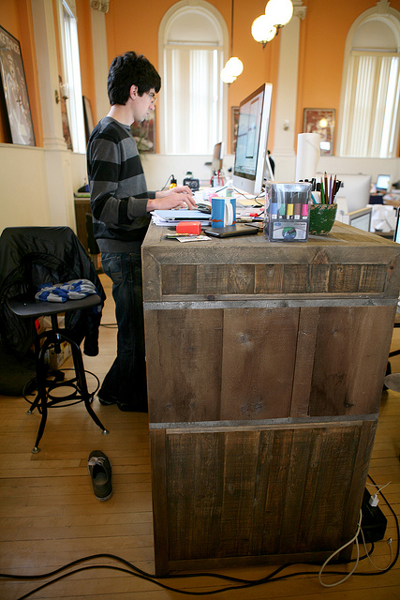
Designer Jen Patel stands to discuss a workflow diagram, while post author Dirk Knemeyer sits deep in thought.
As far back as I can remember, when it was time for my mind to think, it was time for my body to pace.
Not just any thinking, mind you: hard thinking. When a conversation required me to incorporate important new information into my thesis, to solve new problems that at first seemed non-trivial, I was most successful and most comfortable on my feet, stalking around like a caged lion. When I was a young associate, physically dominating small meeting spaces with my movement would have been unacceptable, from a relationship-hierarchy perspective. So now, free to roam regardless of the situation, I am far happier as well as more effective.
Lately I think about my pacing in a more sophisticated way thanks to Juhan’s drum-beating about the dangers of sitting on the job. Now, for we Gen-Xers and Baby Boomers, sitting is what you do at a desk job. It is, after all, called a desk job. But with our increasing awareness of the health risks associated with sedentary work and the meteoric rise in popularity of standing desks, we’re starting to think about this differently. The problem is that the situation is framed in a binary way: sitting is bad, standing is good. Yet, that isn’t completely true. Given a choice between sitting all day and standing all day, standing is better. Yet either sitting or standing all day is bad for you. We really should be doing a lot of moving with some sitting, some standing, and some lying down.
To further complicate things, it is unlikely that any one specific posture for working produces the best results for any of us. Take my pacing example: long before anything but sitting was acceptable for knowledge work, I knew very clearly that there were some tasks for which I needed to be up and moving. At the beginning of this year I got a standing desk. Mine is the kind where you push a button to raise or lower the work surface. So, when working at or around this desk, I am going up and down depending on how my body feels and/or depending on the task at hand. Because once I tried working while standing I quickly realized that there were some tasks for which I simply needed to be sitting if I wanted to do them better or faster or both.
This analysis is purely intuitive and based on my own patterns for work, but I strongly suspect that most people, like me, would do best if they were allowed to change position and movement levels while working. Now, in truth, there is very little that I do better while simply standing. But there are many things I do as well standing as when I’m sitting and, given the health benefit of standing at least some of the time, they just make sense to do in that posture.

Designer Ben Salinas prefers to stand while working much of the time.
Over time I’ve come up with certain task characteristics that form my own criteria for deciding to stand, sit, or pace while doing. Perhaps my list will help you to think about your own relationship between work and physicality.
When I Stand
- Tired and losing focus while sitting. Shifting to a standing position returns some crispness to my thought, at least for a time.
- Writing something that requires very little critical thinking, such as responding to e-mail.
- Reading or just surfing the web without a research component; that is, I have no need to take notes and use what I am consuming toward some future publication.
- Reviewing deliverables from others that do not require really precise and careful review.
- Playing computer games, to give my body some physical benefit when I am otherwise just wasting time.
When I Sit
- Trying to do something that requires both thought and physical output, such as writing seriously or visualizing something.
- Reading when attention to detail matters and/or I really want to enjoy it, not just consume it.
- Carefully reviewing the work of others.
When I Pace
- Deep thinking, trying to dislodge intractable problems or deal with hard/bad news.
- Talking on the phone, so long as it does not require note taking or crisp attention to details.
This list is probably not complete, but it gives you a sense of the diversity of postures that are best for me in a number of different situations. Looking across them, we can distill this list into just a few simple patterns:
- I stand when the work is casual or unimportant. The standing does not detract from the work itself, and is better for me physically.
- I sit when the work requires note taking, attention to detail, and the crafting of physical output. In these cases standing would result (for me) in demonstrably inferior work so I sit instead.
- I pace when trying to really got my mind to work at its hardest, particularly with just-introduced problems and information. I also pace while on the phone because when I’m sitting and talking on the phone I get bored and inattentive.
Most knowledge workers still sit all day at their jobs. For your health, if nothing else, I encourage you to get a standing desk—one that goes up and down, so you can change your posture as the moment requires—and figure out the relationship between your physical posture and activity and the best ways you work. Your body will someday thank you.